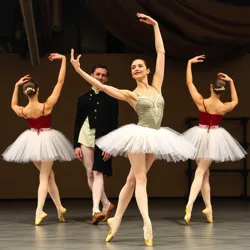Imperial Ballet

Imperial Ballet refers to a style and tradition of ballet that originated in the Russian Empire, particularly through the influence of the Imperial Theatres, which were state-sponsored under the patronage of the Tsars. This style is known for its grandeur, technical precision, and dramatic storytelling.
Origins and Development
The Imperial Ballet began to take shape in the late 19th century, during a period when Russian culture was heavily influenced by European arts. The establishment of the Russian Imperial Theatres in the 18th century marked the beginning of state-supported ballet in Russia. The Imperial Ballet became a prestigious institution, attracting talent from across Europe and fostering the development of a uniquely Russian style of ballet.
Key figures in the development of the Imperial Ballet included Marius Petipa, who served as the principal choreographer for the Imperial Theatres and created iconic works that remain central to the ballet repertoire. His collaborations with composer Pyotr Ilyich Tchaikovsky resulted in masterpieces such as "Swan Lake" and "The Sleeping Beauty."
Characteristics
The Imperial Ballet is characterized by its emphasis on technical skill, with a focus on elaborate footwork and precise execution. It also incorporates elements of traditional Russian folk dance, creating a distinct style that blends classical ballet with cultural nuances.
- Grandeur: Large-scale productions with lavish sets and costumes.
- Narrative: Strong emphasis on storytelling and dramatic expression.
- Virtuosity: High technical demands on dancers, showcasing their skills through complex choreography.
Notable Works
Several ballets from the Imperial era have become staples of the classical ballet repertoire:
- The Sleeping Beauty: A collaboration between Petipa and Tchaikovsky, known for its rich choreography and music.
- Raymonda: Another Petipa masterpiece, celebrated for its intricate dance sequences and dramatic flair.
- La Bayadère: A ballet that showcases the exoticism and romanticism that were popular during the era.
Legacy
The legacy of the Imperial Ballet is evident in the continued popularity of Russian ballet companies such as the St. Petersburg Ballet Society, which still perform many of the classic works from this tradition. The technical and artistic standards established during the Imperial era have influenced ballet schools and companies worldwide, contributing to the development of the Neo-Classical Ballet movement, which blends traditional techniques with modern elements.
See Also
- Russian Imperial Theatres
- St. Petersburg Ballet Society
- Neo-Classical Ballet
References
- Evolution of Russian Ballet
- Influence of Marius Petipa
- Cultural Heritage of Imperial Ballet
The Imperial Ballet remains a testament to the rich cultural heritage of Russia and its impact on the world of ballet. Through its emphasis on technical excellence and dramatic performance, it continues to inspire dancers and choreographers globally.